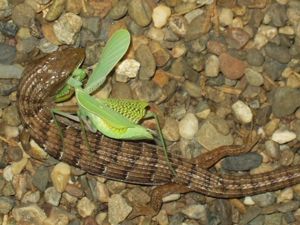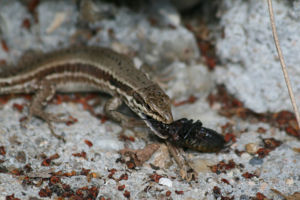Difference between revisions of "Lizard Feeding"
| (18 intermediate revisions by 4 users not shown) | |||
| Line 1: | Line 1: | ||
| − | {{ | + | {{review}} |
| − | [[Image:Elgaria_multicarinata_eating_mantis.jpg|300px|thumb|right|'''A Southern Alligator Lizard (''Elgaria multicarinata'') | + | [[Image:Elgaria_multicarinata_eating_mantis.jpg|300px|thumb|right|'''A Southern Alligator Lizard''' (''Elgaria multicarinata'') <br> Sparkla 2006, WikiMedia Commons]] |
| − | + | ==Introduction== | |
The best diet for a pet lizard is one that is as close as possible to the diet of a free-ranging lizard. Unfortunately not all the ingredients are available. Until controlled studies are done, it is best to feed a variety of foods and not rely on any one to form the bulk of the diet. Regular voracious eating is usually a good indicator of health. It is also necessary to have a feeding arrangement so that food is uncontaminated by litter. | The best diet for a pet lizard is one that is as close as possible to the diet of a free-ranging lizard. Unfortunately not all the ingredients are available. Until controlled studies are done, it is best to feed a variety of foods and not rely on any one to form the bulk of the diet. Regular voracious eating is usually a good indicator of health. It is also necessary to have a feeding arrangement so that food is uncontaminated by litter. | ||
| − | *'''For information on lizard diets and food composition, see''' [[ | + | *'''For information on lizard diets and food composition, see''' [[Reptile Diet Composition|Lizard Diet]]. |
== Herbivore == | == Herbivore == | ||
| − | Herbivorous lizards use microbial fermentation for a significant part of their digestion, have high [[Preferred optimum temperature zone|POTZ]] and require high amounts of ultraviolet light. | + | Herbivorous lizards use microbial fermentation for a significant part of their digestion, have high [[Preferred optimum temperature zone|preferred optimum temperature zone (POTZ)]] and require high amounts of ultraviolet light. |
| − | Animal protein has previously been advised but until proven otherwise it appears best to forego non-plant food sources. It seems that a varied vegetable and fruit diet with added calcium and access to sunlight allows normal growth in iguanas. Time of feeding may be important since free-ranging iguanas bask before eating so it may be better to feed in the late morning. | + | Animal protein has previously been advised but until proven otherwise it appears best to forego non-plant food sources. It seems that a varied vegetable and fruit diet with added [[Calcium - Reptiles|calcium]] and access to sunlight allows normal growth in iguanas. Time of feeding may be important since free-ranging iguanas bask before eating so it may be better to feed in the late morning. |
| − | Ground iguanas, the prehensile-tailed skink, spiny-tailed iguanas, and the chuckawalla generally do well with iguana husbandry techniques. | + | [[Rhinocerous Iguana|Ground iguanas]], the [[Prehensile-tailed Skink|prehensile-tailed skink]], [[Spiny-tailed Iguana|spiny-tailed iguanas]], and the [[Chuckwalla|chuckawalla]] generally do well with iguana husbandry techniques. |
Iguanas will eat leafy greens, vegetables, flowers and fruit that are grated and chopped to a size appropriate to the size and age of the iguana. | Iguanas will eat leafy greens, vegetables, flowers and fruit that are grated and chopped to a size appropriate to the size and age of the iguana. | ||
| − | |||
| − | |||
Feed a varied diet: | Feed a varied diet: | ||
| Line 25: | Line 23: | ||
== Insectivore == | == Insectivore == | ||
| − | [[Image:Lizard_feed.jpg|300px|thumb|right|'''Insectivore''' (Wikimedia Commons)]] | + | [[Image:Lizard_feed.jpg|300px|thumb|right|'''Insectivore''' (© Rémi Jouan, CC-BY-SA, GNU Free Documentation License, Wikimedia Commons)]] |
Crickets should not be more than 50% of the diet and the remainder can include mealworms, king mealworms, wax worms, earthworms, cockroaches, giant cockroaches, flies, cicadas, grasshoppers, field crickets, caterpillars and newborn pinkie mice. | Crickets should not be more than 50% of the diet and the remainder can include mealworms, king mealworms, wax worms, earthworms, cockroaches, giant cockroaches, flies, cicadas, grasshoppers, field crickets, caterpillars and newborn pinkie mice. | ||
| − | Prey items should be fed 72 hours before being offered to the lizard. Commercial preparations are available to feed the insects. Minerals and vitamins can be dusted onto the insects but this is not a substitute for feeding them. The amount of prey items placed in the cage should be equal to the amount than can be eaten at once. | + | Prey items should be fed 72 hours before being offered to the lizard. [[Reptile Diet Composition|Commercial preparations]] are available to feed the insects. Minerals and vitamins can be dusted onto the insects but this is not a substitute for feeding them. The amount of prey items placed in the cage should be equal to the amount than can be eaten at once. |
== Carnivore == | == Carnivore == | ||
| Line 34: | Line 32: | ||
Carnivores should be fed captive bred pre-killed whole prey. In descending order of preference feed: rodents, chicks, fish. Small prey should be fed to smaller lizards and large prey should be fed to the larger lizards. Juveniles should be fed daily and adults once or twice a week. | Carnivores should be fed captive bred pre-killed whole prey. In descending order of preference feed: rodents, chicks, fish. Small prey should be fed to smaller lizards and large prey should be fed to the larger lizards. Juveniles should be fed daily and adults once or twice a week. | ||
| − | Other items can be offered but are less optimal than whole prey. Dog food, cat food and other preparations are not formulated for lizards and should not be used as a significant part of the diet. | + | Other items can be offered but are less optimal than whole prey. Dog food, cat food and other preparations are not formulated for lizards and should not be used as a significant part of the [[Reptile Diet Composition|diet]]. |
| − | [[Category:Lizard_Husbandry]] | + | |
| + | ==Literature Search== | ||
| + | [[File:CABI logo.jpg|left|90px]] | ||
| + | |||
| + | |||
| + | Use these links to find recent scientific publications via CAB Abstracts (log in required unless accessing from a subscribing organisation). | ||
| + | <br><br><br> | ||
| + | [http://www.cabdirect.org/search.html?q=(od:(lizards)+OR+title:(lizard))+AND+(subject:(diet)+OR+title:(diet)+OR+title:(feeding))&fq=sc:%22ve%22 Lizard feeding publications] | ||
| + | |||
| + | [http://www.cabi.org/cabdirect/FullTextPDF/2006/20063121888.pdf '''Insects as food: nutritious and delicious.''' Hernandez-Divers, S. M.; The North American Veterinary Conference, Gainesville, USA, Small animal and exotics. Proceedings of the North American Veterinary Conference, Volume 20, Orlando, Florida, USA, 7-11 January, 2006, 2006, pp 1794-1795, 2 ref. - '''Full Text Article'''] | ||
| + | |||
| + | [[Category:Lizard_Husbandry|F]] | ||
Latest revision as of 13:47, 5 November 2010
| This article has been peer reviewed but is awaiting expert review. If you would like to help with this, please see more information about expert reviewing. |
Introduction
The best diet for a pet lizard is one that is as close as possible to the diet of a free-ranging lizard. Unfortunately not all the ingredients are available. Until controlled studies are done, it is best to feed a variety of foods and not rely on any one to form the bulk of the diet. Regular voracious eating is usually a good indicator of health. It is also necessary to have a feeding arrangement so that food is uncontaminated by litter.
- For information on lizard diets and food composition, see Lizard Diet.
Herbivore
Herbivorous lizards use microbial fermentation for a significant part of their digestion, have high preferred optimum temperature zone (POTZ) and require high amounts of ultraviolet light.
Animal protein has previously been advised but until proven otherwise it appears best to forego non-plant food sources. It seems that a varied vegetable and fruit diet with added calcium and access to sunlight allows normal growth in iguanas. Time of feeding may be important since free-ranging iguanas bask before eating so it may be better to feed in the late morning.
Ground iguanas, the prehensile-tailed skink, spiny-tailed iguanas, and the chuckawalla generally do well with iguana husbandry techniques.
Iguanas will eat leafy greens, vegetables, flowers and fruit that are grated and chopped to a size appropriate to the size and age of the iguana.
Feed a varied diet:
- Greens: mustard green, collard greens, dandelion greens, turnip greens, mulberry leaves, grape leaves, hibiscus and parsley
- Vegetable: beans, peas, turnip, parsnip, squash, sweet potato, zucchini and carrot
- Fruit and flower: papaya, pear, strawberries, raspberries, mango, grapes, apricot, peach, melon, kiwifruit, figs, nasturtium, hibiscus and rose petals
Insectivore
Crickets should not be more than 50% of the diet and the remainder can include mealworms, king mealworms, wax worms, earthworms, cockroaches, giant cockroaches, flies, cicadas, grasshoppers, field crickets, caterpillars and newborn pinkie mice.
Prey items should be fed 72 hours before being offered to the lizard. Commercial preparations are available to feed the insects. Minerals and vitamins can be dusted onto the insects but this is not a substitute for feeding them. The amount of prey items placed in the cage should be equal to the amount than can be eaten at once.
Carnivore
Carnivores should be fed captive bred pre-killed whole prey. In descending order of preference feed: rodents, chicks, fish. Small prey should be fed to smaller lizards and large prey should be fed to the larger lizards. Juveniles should be fed daily and adults once or twice a week.
Other items can be offered but are less optimal than whole prey. Dog food, cat food and other preparations are not formulated for lizards and should not be used as a significant part of the diet.
Literature Search
Use these links to find recent scientific publications via CAB Abstracts (log in required unless accessing from a subscribing organisation).
Lizard feeding publications


